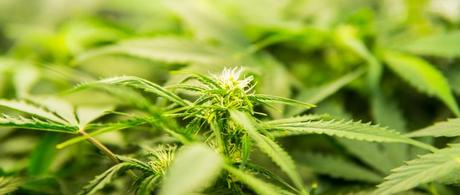
Growing legalisation and adoption of cannabis for the treatment of chronic diseases is positively impacting the potential market growth of this once demonised substance. Additionally, the increased use of hemp and liberalisation of laws related to marijuana around the world are further bolstering revenue growth predictions. In fact, the global cannabis market has been estimated to reach a value of USD 19.89 billion in 2021 and USD 358.8 billion by 2027.
The Asia Pacific region dominates the market, with a revenue share of 41.2 per cent in 2019, owing to the presence of the largest hemp cultivation markets in the region such as China, South Korea, India, and Australia.
Cannabis products today range from the plant itself to infused food and beverages to cannabidiol (CBD oil) that contains no THC and does not get the user 'high'. So, as legal medical - and increasingly, recreational - cannabis becomes more widespread, the cannabis industry is becoming more professional. By adopting the methods and rigour of plant science and analytical chemistry, it is ensuring that it can produce safe, consistent and high-quality products for a fast-growing and lucrative market.
But what should you consider when it comes to developing your own cannabis cultivation facility?
1. Laws & Compliance

Depending on where you live in the world, rules on cultivation of cannabis vary.
In late 2013 and early 2014, Uruguay became the first country that legalized both use (recreational and medicinal) and home cultivation of cannabis plants. However, while locals are allowed to buy marijuana for recreational purposes, foreigners are prohibited from buying. Canada legalized the use of cannabis for medicinal purposes in 2001, while the Federal Cannabis Act legalized its use for recreational purposes 17 years later. In mid-September 2018, the South African Constitutional Court decriminalized the cultivation and use of marijuana in private settings. But even though private use of marijuana has been wholly decriminalized, selling or buying cannabis, along with all cannabis-based products like oil and seeds, remains illegal.
Other countries, including The Netherlands, Belgium, Spain, the USA and several other countries all have individual laws around the cultivation and medicinal or recreational use of marijuana.
2. Shipping

There are still strict laws about distributing and shipping cannabis, whether that's within your own country or internationally. In America, as more and more states begin to legalise the recreational use of cannabis, domestic delivery of cannabis has surged - further accelerated by the pandemic and subsequent lockdowns. For example, Khaled Naim, the CEO and co-founder of Onfleet, a San Francisco-based delivery management software company, raised $14million in October 2020 to scale his business and keep up with the pandemic-inspired growth. And for Sava, a high-end cannabis delivery platform that serves 70 cities around San Francisco, the pandemic drove a 60 per cent sales surge since orders were first mandated in March 2020.
According to Eurosender6, the rules for shipping cannabis products typically depend on the regulations of the countries of collection and delivery, and the regulations of the courier company selected. Some general guidelines that apply are:
· It is legal to ship cannabis-derived products within the European Union with a THC concentration of up to 0.2%.
· In the UK, businesses can sell products containing no more than 1mg of the substance per container.
· In the US, shipping products derived from marijuana by post or courier is legal as long as they contain less than 0.3% THC.
· In Australia, the allowed amount of THC in products is 0.005% or less.
3. Branding and marketing your cannabis supply

Cannabis comes in such a vast amount of forms, and has different uses for different people - medicinal users, recreational users and logistical users such as those require hemp for building products, for example - so developing branding and a marketing strategy will be complex. Add to that the many different rules globally around the use and cultivation of cannabis, and you will need a multi-tier plan that covers all bases.
You'll need to consider how to price your products, where and how you'll distribute them, who you're going to prioritise as a target audience and what the messaging needs to be to engage them with your business. With the cannabis marketing being flooded with new brands every year it is important to style out with not just a quality product, but with a brand that is attractive to the end user.
4. Product quality

As more countries begin to legalise the use and cultivation of cannabis, attention will turn to the quality of materials being produced and distributed by those who build large plants and growing facilities. Experts note various features and characteristics of cannabis, which instantly identify whether it is high grade, mid-grade or low standard. These include colour, stem and seed content, aroma and taste, trichome count, bud structure and trim. However, some legal cannabis has been found to contain fertiliser, extremely high THC levels and even heavy metals and fungus. The expectation is that as cultivation of cannabis becomes more commonplace, legislation on its quality will become stricter over time.
5. Waste management and disposal of cannabis product

Legalising cultivation of cannabis is creating a waste management problem. The growing of Marijuana on a commercial scale creates large volumes of waste plant matter.
The transportation and disposal of cannabis waste is specialized and requires special licensing and compliance; you must meet various regulatory requirements whilst also adhering to local environmental standards. In some states and countries, failure to meet cannabis waste disposal requirements can lead to monetary fines up to $15,000 and/or cancellation of a cultivation license.
Incineration is the most effective, bio secure and safe method to treat cannabis waste. Any cannabis waste should be ground up and mixed prior to destruction, at an approx. 50/50 ratio with other non-compostable waste such as cardboard, paper and plastics. Cannabis waste is typically categorised as:
· Marijuana plant waste not processed with solvents (stalks, leaves and stems)
· Tetrahydrocannabinol (THC) contaminated materials
· Solid marijuana sample plant waste
· Marijuana Waste processed with solvents.
Any plant waste processed with solvents is classed as hazardous waste and must, therefore, be disposed of through a licensed landfill or better still through incineration.
Here at Inciner8, we've established ourselves as the go-to partner for safe and efficient incinerator solutions for waste generated from cannabis farming, with our systems in operation around the world.
From smaller operations to large scale facilities that produce tonnes of cannabis waste every single day, we enable sites of any size, located anywhere across the globe, to use our products by providing on the ground training and ongoing advice to even the most remote of users. Plus, we work closely with logistics experts to ensure our incinerators are correctly packaged and delivered so that they reach customers in full working order, whether they're road, ship or air freighted.
If you need to find more information regarding processing your waste on site, in a safe, quick and efficient manner, visit our cannabis page HERE or alternatively call us on +44 (0) 1704 884020 or email our expert sales advisors at [email protected].

